Digital Image Correlation
One of the many facets of this project is testing the member connections of the Memorial Bridge in Portsmouth. The research team is especially interested in this because these new type of connections are relatively untested and we want to see how they hold up over time. The main way that this is tested is by doing strain testing. Traditionally, this is done by using strain gauges, which have to be manually placed on the bridge. This type of strain measurement is the most accurate type of measurements, but it is also the most time consuming, the most expensive, and also could potentially damage protective coatings on the bridge. Because of these drawbacks, the research team has been investigating and employing a new technique of testing.
 This new type of testing is called Digital Image Correlation (DIC) and uses GoPro cameras to conduct the tests. The way this type of testing works is that a GoPro camera is mounted to the member that is being tested, whether it is in the lab or on the bridge, using a “gooseneck” attachment. Then, the camera is used to take a video of the strain tests, usually about one minute. After this, the video is broken down into thousands of frames which can be analyzed by the software. These frames are then put through a piece of software called Vic-2D, which will go frame by frame and measure the distance between pixels from the previous pictures. The software will then translate this to an excel file, where the research team can graph out the strain and figure out what it means for the health of the members.
This new type of testing is called Digital Image Correlation (DIC) and uses GoPro cameras to conduct the tests. The way this type of testing works is that a GoPro camera is mounted to the member that is being tested, whether it is in the lab or on the bridge, using a “gooseneck” attachment. Then, the camera is used to take a video of the strain tests, usually about one minute. After this, the video is broken down into thousands of frames which can be analyzed by the software. These frames are then put through a piece of software called Vic-2D, which will go frame by frame and measure the distance between pixels from the previous pictures. The software will then translate this to an excel file, where the research team can graph out the strain and figure out what it means for the health of the members.
When it comes to Digital Image Correlation, there are numerous advantages as well disadvantages when compared to normal gauge testing. The major advantage is the ease of testing. For DIC testing, the only piece of equipment needed is the GoPro camera, all of the data is stored in the camera, and the rest of the post-processing can be done in the lab. When it comes to using a physical strain gauge, there are many more steps that are necessary. First of all, these gauges require that the protective coating on the bridge must be ground off which can permanently damage the bridge. The GoPro cameras do not require this, they can just be clamped onto the member. 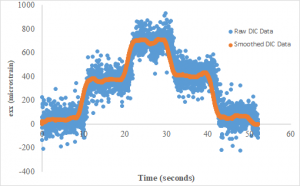 Also, for the foil gauges there is quite a bit of wiring involved which must be connected to a Data Acquisition system (DAQ). This DAQ also must be connected to a computer which makes for a lot of equipment on site. This is the biggest advantage of DIC over traditional strain testing, the amount of equipment is much less and there is no damage to the bridge. One of the main disadvantages of DIC is that it can be less accurate than traditional testing, especially if the camera is hit or moved during testing. Digital image correlation software is an innovative new technique that can be used for structural health monitoring without the need for extensive equipment.
Also, for the foil gauges there is quite a bit of wiring involved which must be connected to a Data Acquisition system (DAQ). This DAQ also must be connected to a computer which makes for a lot of equipment on site. This is the biggest advantage of DIC over traditional strain testing, the amount of equipment is much less and there is no damage to the bridge. One of the main disadvantages of DIC is that it can be less accurate than traditional testing, especially if the camera is hit or moved during testing. Digital image correlation software is an innovative new technique that can be used for structural health monitoring without the need for extensive equipment.
Written by Jake Daniels.
Research performed by Jake Daniels and Travis Manning.
Model Updating, SHM and Damage Detection
Suitable mathematical representations of the structures are available today for predicting the characteristics of the engineering structures. However, the computer simulations need to be corrected based on the measured data to minimize the discrepancy between the analytical predictions and test results. This correction is known as model updating. Therefore, an objective function is formulated in terms of the discrepancy between numerical and experimental quantities, and an optimization algorithm is employed to minimize the objective function.
Tracking structural integrity and estimating the damage nature in a structure is referred to as health monitoring. Finite element model updating can be a way of structural damage identification. If the model is updated so that it represents the healthy condition of the structure, it could be used as a base model for future condition assessment and damage detection. For this purpose, the data corresponding to the damaged condition of the structure is considered for the updating process. When the updating is done, the new estimated parameters indicate the damage in the structure.
For the model updating and health monitoring of the Memorial Bridge, a MATLAB-based model updating software developed at the University of New Hampshire is used. The software, called MUSTANG (Model Updating STructural ANalysis proGram), is linked to SAP2000 using its application programming interface (API) to perform parameter estimation for the bridge.
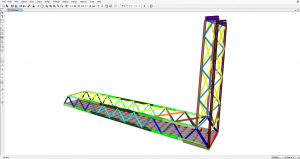
Written by Milad Mehrkash.
Tidal Energy Resource Assessment
A tidal energy resource assessment was performed for a potential long term tidal energy conversion installation on the Memorial Bridge in Portsmouth New Hampshire in the Piscataqua River. The purpose of the assessment was to select and size a turbine for the location, determine the feasibility of and size a battery bank and to quantify the amount of available kinetic energy in the water that could be converted into electrical energy. The assessment primarily used data collected by one bottom deployed acoustic Doppler current profiler (ADCP) survey (HG-14) performed near the planned deployment site to characterize the currents at the site. The data from an additional bottom mounted ADCP survey (K-07) and vessel mounted ADCP transects were used to provide additional information about the currents nearby the site.
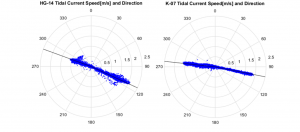
Based on the tidal current data collected during the ADCP survey closest to the deployment and average estimated power requirements current data, a turbine and rotor size were selected. A systems model was used to simulate a battery bank, tidal generator, and a power load. Using this model, utilization factors for various battery-rotor-load configurations were compared to the available tidal energy during the survey period. An annual energy production estimate (AEP) was made based off a commercially available tidal turbine’s power curve and the ADCP survey results.
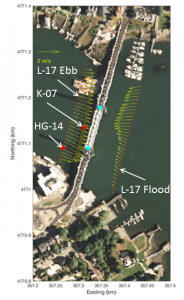
A crossflow vertical axis turbine with a 3mx2m rotor was selected for this site. It was estimated that this turbine would produce approximately 2kW of power on average, and 10kW at peak. The turbine is estimated to produce 13,008kWh per year of electrical energy which is enough energy for approximately 2 US homes.
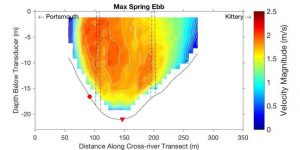
This work is in preparation for a journal paper by authors Ian Gagnon, Martin Wosnik, Thomas Lippmann, Ken Baldwin, and Erin Bell to be published in the International Journal of Marine Energy.
Fatigue Assessment/ SHM/ Model Verification
The Memorial Bridge is a vertical lift bridge in which the lift operation provides a repeatable, controlled excitation applied only to the bridge structure on random schedule, requiring for measuring cyclic response (strains) for fatigue studies. In addition, the gusset-less truss connection is unique to this bridge and is the only connection of its kind in a vehicular bridge, which makes the verification of the design procedure vital for future applications of this connection type.
The limited information about the performance of the gusset-less connection, the influence on the global behavior of the bridge, lack of detailed information on load rating in the current codes raise the demand for a comprehensive monitoring program. Other challenging issues in the bridge such as the vulnerability to potential damages, fracture critical locations, and fatigue crack initiation and propagation under various service loads including traffic live load, lift operation impact and environmental loads can be addressed through a long-term monitoring program.
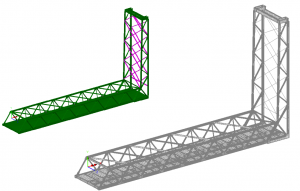
The installed monitoring plan on the Memorial Bridge designed based on achieving a profound understanding of the gusset-less performance by installing a cluster of sensors at the connections. Data based fatigue assessment approaches are capable of determining only remaining life of the components which are instrumented with sensors. Determining all critical locations prone to fatigue merely through monitoring demands for virtual number of sensors which is not applicable for large-scale bridge structures. Therefore, given the practical restrictions of sensors deployment in real-field situations, finite element models have the distinct advantage of giving the exact positions, directions, and magnitudes of high stresses and the patterns of stress distribution in the entire zone of interest. Providing a global model of the structure can yield valuable information on required scale which can act as a benchmark for future damage assessment of the structure. In addition, the model when calibrated and updated through monitoring data has the advantage of to be employed to explicitly diagnose the root reason of detected abnormal behavior of the bridge as well as identifying the impact of such changes on the entire performance of structure.
Written by: Maryam Mashayekhizadeh
Fatigue Testing of a Gusset-less Connection
In a parallel project funded by the New Hampshire Department of Transportation (Evaluation of Gusset-less Truss Connection to Aid Bridge Inspection and Condition Assessment), two scaled sections of a typical lower-chord gusset-less connection will be tested for fatigue loading at the UNH Structural Engineering Laboratory. The purpose of these tests is to evaluate the fatigue performance of intact welds as well as welds with defects located along the bend radius of the connection. The connection specimens will be exposed first to cyclic stress ranges consistent with the design stress ranges. Cyclic stress ranges will then increase up to the design allowable stress range, and if the specimen does not fail, stress ranges will be further increased until failure is imminent.
The results of these fatigue testing are important for understanding and quantifying the fatigue performance of this unique connection, to inform not only Memorial Bridge inspection protocols but also the development of reliable numerical models that could be useful for long-term bridge management purposes. In addition, the results obtain from this study will provide valuable data useful to evaluate the potential incorporation of gusset-less connections into future bridge designs.
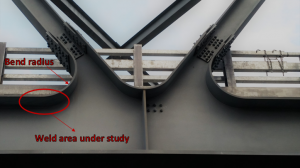
Written by Fernanda Fischer